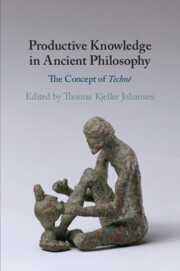Book contents
- Productive Knowledge in Ancient Philosophy
- Productive Knowledge in Ancient Philosophy
- Copyright page
- Contents
- Contributors
- Acknowledgements
- List of Abbreviations
- Introduction
- Chapter 1 Protagoras on Political Technê
- Chapter 2 Dynamic Modalities and Teleological Agency
- Chapter 3 Technê As a Model for Virtue in Plato
- Chapter 4 Crafting the Cosmos
- Chapter 5 Aristotle on Productive Understanding and Completeness
- Chapter 6 Technê and Empeiria
- Chapter 7 The Stoics on Technê and the Technai
- Chapter 8 The Epicureans on Technê and the Technai
- Chapter 9 The Sceptic’s Art
- Chapter 10 Plotinus on the Arts
- Chapter 11 Productive Knowledge in Proclus
- Bibliography
- General Index
- Index Locorum
Chapter 9 - The Sceptic’s Art
Varieties of Expertise in Sextus Empiricus
Published online by Cambridge University Press: 14 January 2021
- Productive Knowledge in Ancient Philosophy
- Productive Knowledge in Ancient Philosophy
- Copyright page
- Contents
- Contributors
- Acknowledgements
- List of Abbreviations
- Introduction
- Chapter 1 Protagoras on Political Technê
- Chapter 2 Dynamic Modalities and Teleological Agency
- Chapter 3 Technê As a Model for Virtue in Plato
- Chapter 4 Crafting the Cosmos
- Chapter 5 Aristotle on Productive Understanding and Completeness
- Chapter 6 Technê and Empeiria
- Chapter 7 The Stoics on Technê and the Technai
- Chapter 8 The Epicureans on Technê and the Technai
- Chapter 9 The Sceptic’s Art
- Chapter 10 Plotinus on the Arts
- Chapter 11 Productive Knowledge in Proclus
- Bibliography
- General Index
- Index Locorum
Summary
At Against the Mathematicians (M) 2.10 Sextus Empiricus defines technê along Stoic lines, as (a) an organized system of knowledge (b) directed towards an end useful for life. This raises a question. Does the sceptic’s own art satisfy conditions (a) and (b) and thereby qualify as a technê? This is not an idle question. For if it turns out that the sceptic’s art does qualify as a technê, then one might reasonably ask whether, on pain of inconsistency, Sextus ought not to train his guns on the sceptic’s art just as he trains his guns on the liberal arts of grammar, rhetoric, geometry, arithmetic, astrology and music in M 1–6. The chapter explore the different possible answers that can be given to the question and argues that, though scepticism satisfies condition (b) for a technê, it fails to satisfy condition (a). While skepticism has eudaimonistic use, in that establishes ‘unperturbedness’ (ataraxia), not fixed target or subject matter like technai proper, but one that changes according to dialectical context. Skeptic art has then an asystematic subject matter. Scepticism is, therefore, a non-technical art that differs fundamentally from the kinds of technai Sextus discusses, and attacks, in M 1–6.
- Type
- Chapter
- Information
- Productive Knowledge in Ancient PhilosophyThe Concept of <I>Technê</I>, pp. 226 - 244Publisher: Cambridge University PressPrint publication year: 2021
- 2
- Cited by



